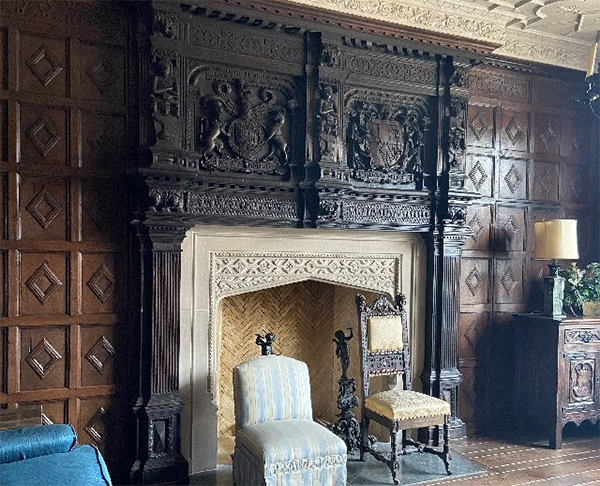
In 2016 we reported on research carried out by Anne Hurst who had been able to trace the whereabouts of oak panelling and chimney pieces taken from Standish Hall after the estate was sold in 1921 (Newsletter No.191). She had discovered John Harris's book entitled 'Moving Rooms - The Trade in Architectural Salvages' which indicated that all the woodwork from two of the rooms had been sold by auction to the wealthy newspaper magnet, William Randolph Hearst. After his death in 1951 the panelling was apparently gifted in 1958 to the Detroit Institute of Arts (DIA) where it was assumed it remained.
Not so according to local historian, Andy Lomax, who has been able to establish more about what happened to the material from the Standish Hall sale. He points out that Harris's book mentions the dealers selling items to another newspaper proprietor, Ralph Booth from Detroit, for a large new family house he was building in Michigan. Specifically mentioned is a William & Mary oak library from Standish Hall. Booth's house was recently sold and the estate agent described it as having a fireplace and walnut panelling from "Standish London" (this is curious as all the Standish Hall material is recorded as being oak).

Andy also discovered that in 1938, the rooms in the Hearst collection went on sale and one was sold to Tony Hulman for a room in a lodge he was building in Terre Haute, Indiana (Tony Hulman is famous for buying the Indianapolis 500 racing circuit). It seems therefore that only one room went to the DIA. This information comes from a book written in 2014 by a Sigur E. Whitaker, who also, unfortunately, reports that the lodge burnt down in 1965.
Recently however, one of our members, Jim Meehan, writing a piece for Standish Library, has learned something different. Researching independently, he came across an article in an Indiana newspaper, the Tribune-Star (dated 1977), which in fact, suggests that the lodge with the room had not been destroyed. Whitaker, it turns out, had been referring to a completely different lodge. Hulman died in 1977, but the lodge with the room remained in his family who very recently donated it to the Rose-Hulman Institute of Technology. Jim has been in touch with the Institute to check that the room still exists. They confirmed that it is being well looked after (being currently used as a resource for the college). The college President has kindly sent these photos of the room. The chimney piece displays the coat of arms of James I on the left and the coat of arms of the Bindloss/Eltoft family on the right. As mentioned in our 2016 Newsletter, the fireplaces and panelling originally came from Borwick Hall, seat of the Blindoss family. In 1697 William Standish (famously implicated in the Jacobite plots of 1690/4) married Cecilia Blindoss, heiress of Borwick. They made Standish Hall their family home but it isn't certain whether the panelling was moved by them or their son Ralph. As it happens, Jim has also been able to establish the location of a fourth room which was sold by the auctioneers in the early 1920s. Described in the sale as the "Oak Dinning Room", Jim has traced this room to Halsway Manor in Somerset where the interior was renovated in 1924.
Jim says he was already aware that the large oak entrance doors at Towneley Hall in Burnley, also originated from Standish Hall. We know Cecilia Towneley inherited the Standish Estate in 1755 but it is not clear when the doors were moved. Presumably it will have been before the Hall was sold in 1921. An article in Country Life from 1913 suggests it was moved when Standish Hall was "partly destroyed in 1780".
This is particularly detailed research which has resulted in us knowing more or less where the majority of the inernal fittings of the Hall ended up. All three researches, Anne, Andy and Jim have done a great job and I would like to thank them for their efforts. However there are still some loose ends, e.g. what happened to the Chapel and Tudor wing of the Hall and also why was the panelling in the house in Michigan reported as walnut. Hopefully one day these mysteries will also be solved.
Next Meeting
As reported in last month's newsletter there does not seem to be any prospect of a Society meeting anytime soon. There may, however, be opportunities for fieldwork or site visits if social distancing can be maintained. I will keep everybody informed of any developments.
|



